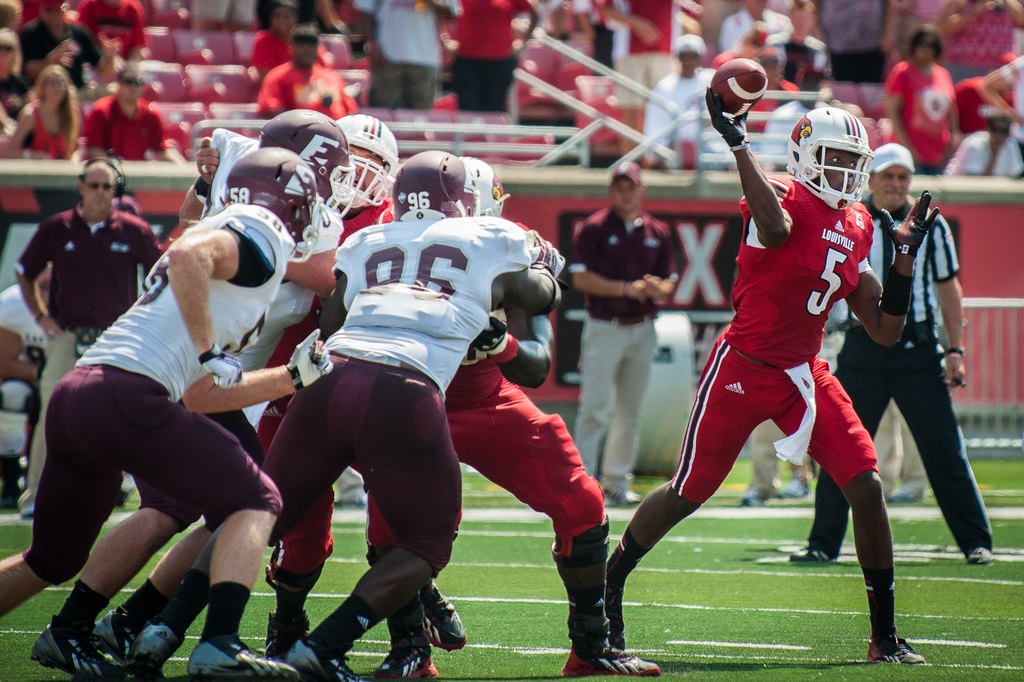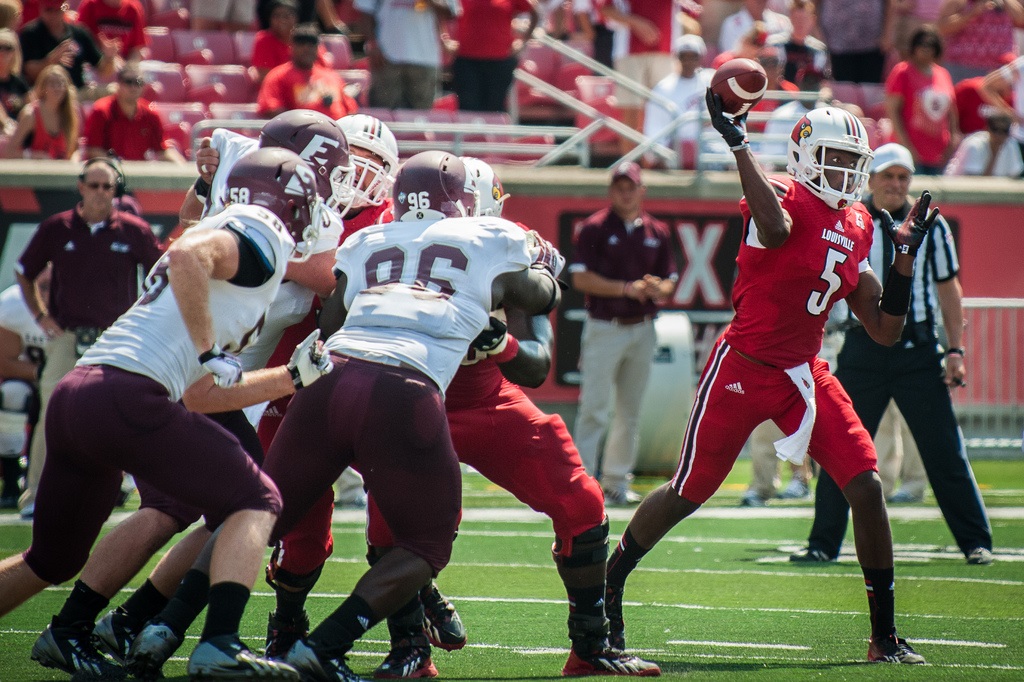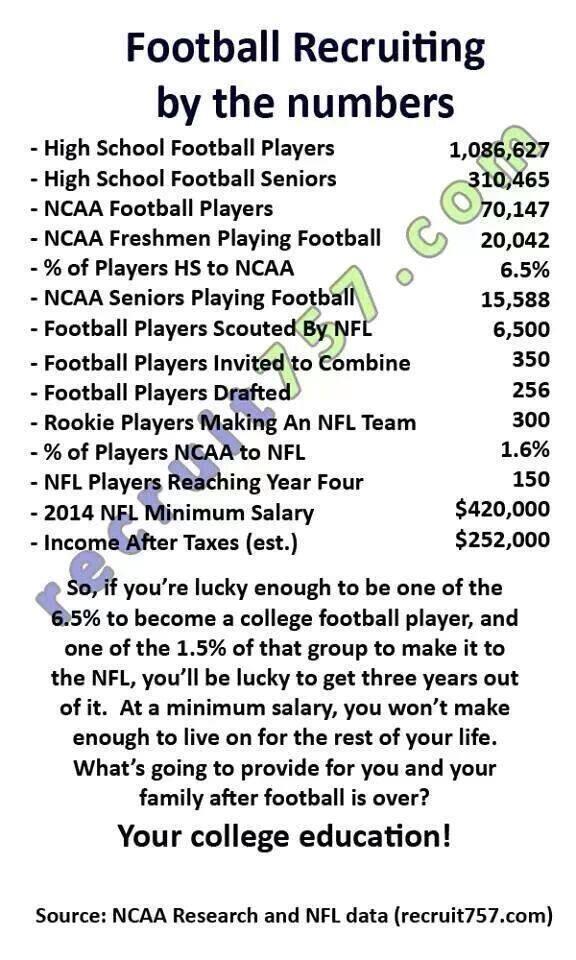 Many draftniks are lukewarm about Ka’Deem Carey’s prospects, but it’s the little things he does that generate big plays that get me excited about his future.
Many draftniks are lukewarm about Ka’Deem Carey’s prospects, but it’s the little things he does that generate big plays that get me excited about his future.
A scout told me this spring that Ka’Deem Carey is the type of runner that scouts like and coaches love, but makes personnel executives squint their eyes. Carey’s off-field domestic violence charge early in his college career is a viable reason for scrutiny, but it’s not the reason the scout I spoke with says that some big wigs in NFL front offices weren’t jumping on board with their staffs.
Carey is a punishing runner for a back that weighed less than 210 pounds at the combine. He also ran a 4.7-40, which is by no means a death knell for a running back, but the front office sees the smaller stature, the average speed, and a career built on volume and the risk management hat comes on.
However, coaches love the intensity that a player like Carey brings to the game and the Bears have the kind of offense where I believe the rookie can develop into a feature back when Matt Forte’s contract expires. Carey’s 21-carry, 138-yard night against USC that included 10 first downs, 11 broken tackles, and 6 catches for 36 yards offers some quality moments that illustrate why I hold this view of the Bears’ fourth-round pick.
A quick suggestion: Set the speed to “0.5” on YouTube’s playback settings “the cog” icon on the bottom right of the video player before viewing each highlight.
Turning Losses Into Gains
Quickness and agility are more important than speed to a running back and vision to identify and avoid trouble trumps all three. This third-down run from a 2×2 receiver, 10 personnel shotgun set with 13:47 in the third quarter is a not against a packed box, but it’s still a good demonstration of what I’m talking about. Carey’s offensive line slants left and the runner intends to split the tackle and guard on that end to the flat.
However, USC ‘s tackle gets strong penetration up the middle to cut off this gap as Carey is taking the exchange with the quarterback. By the time Carey has the ball and a step past his quarterback, this tackle is two yards deep in the backfield and is blocking the widest gap at the line of scrimmage.
Carey has already identified the penetration and taking action. His first step is a hard plant and dip inside, but it’s not enough to avoid the tackle’s angle and he knows it. Some running backs will try to cut off the inside foot and lose balance.
Not Carey. He completes the second step with a turn, but it’s a quick step so he can plant harder with the outside leg to maintain balance and generate burst. It’s a minor adjustment that gets him inside the penetration and downhill with balanced pad level.
Now Carey can attack the defense in the middle of the field while avoiding the outside gap protection of the defensive back. He’s also in position to keep his knees high to run through the defensive back’s wrap.
[youtube=http://youtu.be/pLUfSGnNAI4&start=167]
He finishes the play backing his way to the Arizona 43 for a gain of eight on what could have been a loss of three. As I said, quickness and agility are more important than speed to a running back and vision to identify and avoid trouble trumps all three. Wash. Rinse. Repeat.
High Knees
This 39-yard gain highlights Carey’s average speed, but what I like is the finish. Once again this is a run where USC is expecting pass, but I love how Cary pressed to the inside shoulder of the left tackle to force the defensive tackle inside and then cuts to his blocker’s outside shoulder to hit the smaller crease between the left tackle and H-Back.
This press and cut not only sets up the initial hole, but it baits the middle linebacker to slide outside and give the left guard the angle he needs to seal the edge at the second level. This is fine inside running by Carey, because if he tries to beat the defensive tackle inside, the linebacker is already in position to end this play early. Instead, Carey sets up the smaller crease and in turn sets up guard’s block.
The reward is a first down and another 29 yards. As Carey gets 20 yards into the run, note how high he lifts his knees as he anticipates and runs through contact.
[youtube=http://youtu.be/pLUfSGnNAI4&start=201]
Carey gains another 14 yards in part to running with his knees high. The Bears’ new runner may not break long touchdown runs, but he’ll have a lot of runs of 15-25 yards that matter.
Integrating Both Skills From Above
This is another third-down run early in the fourth quarter where Carey essentially faces a five-man front with six at the line of scrimmage. Again, these are favorable numbers for the ground game, but not when a defensive tackle swims past the center and beats the right guard assigned to him. The defensive tackle is a yard deep int the backfield with a good angle before Carey even takes the exchange.
Carey plants hard as he takes the exchange and turns his hips away from the reach of the defender who is almost four yards into the backfield.
[youtube=http://youtu.be/pLUfSGnNAI4&start=233]
He then bursts down hill with high knees through the crease, earning the first down and carrying a defender for a 12-yard gain on what could have been a three-yard loss.
Reading the Field A Level Ahead
Finding running backs with the capability to read and set up defenders a level ahead of the ball carrier’s current position is not as common as one might think. Most running backs–even in the NFL–read one level of defenders at a time. This 1st and 10 run with 10:11 in the game is a good example of Carey reading a level ahead. It’s a play that I think is easy for some analysts to get wrong and characterize it as Carey “wasting movement.”
Carey flanks the left side of the quarterback in this pistol set with 2×2 receivers. USC plays off coverage on the receivers and both safeties are deep enough that the defense is expect pass, but the linebackers are still in good position to defend the run. As Carey takes the exchange from the quarterback, note linebackers No.10 (middle of field) and No.56 (accountable for the left flat in the short zone).
No.10 maintains good position to defend the inside and prevent a cutback to the middle. No.56 does a strong job of reacting tot he hole between left guard and left tackle, flying towards the gap after accounting for the slot receiver and verifying the exchange between the quarterback and runner. However, watch Carey read No.56, bounce the play three steps to the outside, and force No.56 to account for the edge.
[youtube=http://youtu.be/pLUfSGnNAI4&start=252]
I believe Carey knew exactly what he was doing on this run: He saw the hole and the linebacker’s reaction, baited the defender outside, and all the while was prepared to spin his way inside and back his way through the small crease for positive yards. This is a lot like a two-way go, but Carey knows he’s operating in a tight space and has to factor the two first-tier defenders into his movement.
One of the reasons I believe Carey knew what he was doing is his spin move. He doesn’t try to do a complete 360-degree turn. If he does, the tackle plants him behind the line of scrimmage. Only a runner that does not see or feel the tackle working down the line tries a full spin. It’s the type of 360 move that at one time Darren McFadden might have tried on a zone play and failed. Carey spins so his back is to the defender and he has leverage to drive through the hit and earn yards.
A three-yard gain doesn’t seem impressive in the box score, but this is a good example of process trumping the product. Carey makes a good decision and is fast enough to set up the move while factoring four defenders into his choice, gaining three yards instead of potentially bouncing outside or cutting back for a loss or executing a full spin for no gain.
Some scouts would examine this run and label it a good example of “feel” or “intuition.”
Plays Big In Tight Quarters
The previous play was an example of how Carey leveraged his size for maximum power in a situation where he could have been planted into the ground by a much bigger man. This reception and run for a first down on 3rd and 7 with 9:40 in the game is technically a “space play” based on the location, but the room Carey has to operate in the flat as he makes the catch and run is anything but.
Once again this is a 2×2 receiver, 10 personnel shotgun set with Carey flanking the quarterback’s left side. USC has one safety deep middle and the rest of the coverage on the receivers is six yards off the line of scrimmage. Six USC defenders pack the box pre-snap. USC sends four–including two defenders towards the left edge, which leaves the flat open until the middle linebacker can sprint across to account for Carey swing from the backfield.
Arizona’s quarterback does a good job holding the defense in the middle of the field long enough for the linebacker to account for the crossing route moving under him left to right. This look-off paired with the shallow cross leaves Carey open in the flat and forces the defensive back to drive up field from the Arizona 45 towards Carey working towards the ball at the line of scrimmage at the 35.
Carey feels the presence of the defensive back over top and extends his arms to attack the ball at the 39. It’s a play that, if he misses, he might have been accused of alligator arms, but upon repeated viewings I think the ball was far enough and low enough that Carey had to extend the way he did to make the catch and the presence of the defensive back was a secondary factor, at best.
Once Carey makes the catch, he illustrates the awareness to spin, avoid the big hit, and force a wrap. Once achieved, Carey has pad level and leg drive to drag two players four yards. He crossed the first down marker and gains another three. Not a Lache Seastrunk display of disappearing in thin air and taking the ball another 40 yards, but also a play that Lache Seastrunk does not make 9 times out of 10 at his current level of skill.
[youtube=http://youtu.be/pLUfSGnNAI4&start=274]
Carey flashes the skill to concentrate on what he needs to do in the moment while anticipating what comes next. He’s also consistent and finishing strong. It’s easy to forget his weight is in the range of 207-210 pounds. I think he’ll add weight and explosion within the next year and it will only accentuate these positives of his game.
Tight quarters isn’t just winning against multiple defenders on top of you; navigating a sideline is another example. Here’s a catch as a check-down option after the play breaks down. Carey works across the formation towards the edge defender, but the quarterback is forced to scramble to Carey’s side due to interior pressure and Carey loses position on the defender because of the quarterback’s roll out.
The runner knows that it’s now time to work open as a receiver and he sprints to the right flat. The quarterback makes the throw and Carey makes the catch on the run five yards behind the line of scrimmage, but with the sideline open to him.
The pursing defensive linemen has an angle as Carey crosses the line of scrimmage to the sideline and there’s a defensive back over top and charging up the sideline. Carey stutters to freeze the two defenders, set up a block on the lineman, and plays give-a-leg-take-a-leg on the cornerback at the sideline. Even with the move to avoid much of the corner’s hit, Carey still gets hit hard on the leg, five yards past the line of scrimmage, maintains his balance while straddling the boundary and gains another five yards for the first down before the linebacker pushes the runner out.
[youtube=http://youtu.be/pLUfSGnNAI4&start=313]
It’s a tough play that appears easy when Carey executes it. It’s something I could say about all of these examples. It’s probably why football players and coaches are excited about him, but writers are lukewarm.
For analysis of skill players in this year’s draft class, download the 2014 Rookie Scouting Portfolio and the RSP Post-Draft. Better yet, if you’re a fantasy owner the 56-page Post-Draft Add-on comes with the 2012 – 2014 RSPs at no additional charge and available for download now. Best, yet, 10 percent of every sale is donated to Darkness to Light to combat sexual abuse. You can purchase past editions of the Rookie Scouting Portfolio for just $9.95 apiece.














